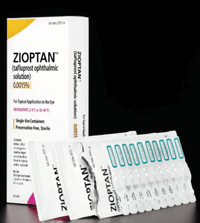 A 60-year-old man recently was referred for glaucoma management. The diagnosis was very straightforward, and the severity was only moderate. However, treatment was a challenge.
A 60-year-old man recently was referred for glaucoma management. The diagnosis was very straightforward, and the severity was only moderate. However, treatment was a challenge.
The patient had a history of intolerance to numerous glaucoma medications due to severe dry eye. He had tried several common glaucoma medications, but suffered greatly with each formulation.
After each trial, he presented with significant redness and irritation. His tear film break-up time (TFBUT) was reduced to two to three seconds, and there was diffuse punctate staining across each cornea. The situation improved a little when he wasn’t using the medications; however, his symptoms came back with a vengeance when he used any medication preserved with benzalkonium chloride (BAK).
Several issues arise when we start to think about glaucoma management in the context of ocular surface disease (OSD). Common symptoms of OSD include variable and intermittent blurred vision, itching, burning, stinging, grittiness, redness, irritation, dryness and excessive tearing. We now understand that glaucoma therapy may exacerbate or even cause OSD. Clinicians who manage glaucoma patients with early or preexisting OSD must act to improve their patients’ ocular surface health and thereby enhance their quality of life.
OSD in Glaucoma Patients
Using the Ocular Surface Disease Index to account for patients’ subjective comfort and visual difficulties, one study of 630 patients indicated that OSD occurred in 48.4% of those using topical agents for glaucoma.1 Of these, 21.3% of patients reported mild symptoms, 13.3% reported moderate symptoms and 13.8% reported severe symptoms.1 Patients on multiple medications reported even higher scores.
In early clinical trials, Anton Hommer, M.D., and associates examined
the efficacy and tolerability of tafluprost in 544 patients. They found
that tafluprost was an effective, well tolerated and safe medication in a
patient population with unsatisfactory IOP control and/or poor
tolerability issues with their former medication(s).7 In a third study, tafluprost was better
tolerated than BAK-containing latanoprost, exhibiting lower tear
osmolarity levels while maintaining effective IOP control.9 Another
research team documented that the overall IOP-lowering effect of
tafluprost was similar to that demonstrated by travoprost, latanoprost
or bimatoprost in patients who were intolerant to the latter three
PGAs.10 However, when each PGA was individually compared with
tafluprost, bimatoprost seemed to provide an additional statistically
significant IOP-lowering effect.10
Another study indicated that travoprost
0.004% monotherapy produced lower diurnal IOP than tafluprost 0.0015% in
patients with primary open-angle glaucoma or ocular hypertension, while
exhibiting a similar safety profile.11 Finally, in an investigation of the
tolerability and IOP-reducing effect of preservative-free tafluprost in
patients who previously exhibited ocular surface side effects during
latanoprost therapy, researchers saw that tafluprost maintained IOP at
the same level as latanoprost, but was better tolerated.12 Also,
patients who received preservative-free tafluprost reported improved
quality of life and increased overall satisfaction.12
In another study of 101 subjects who received topical glaucoma therapy, the authors documented that 59% of patients experienced OSD symptoms.2 Additionally, Schirmer testing revealed that 61% of patients exhibited decreased tear production in at least one eye. Corneal and conjunctival lissamine green staining showed epitheliopathy in 22%, and TFBUT was abnormal in 78% of patients.2 Further, a severe decrease in tear quality was found in 65% of patients.
Tafluprost
Appears More Tolerable
 In another study of tolerability and
efficacy, researchers found that switching treatment to tafluprost in
patients who were already being treated with another PGA resulted in a
statistically significant improvement of all symptoms
evaluated––including stinging/burning/irritation, itching, foreign body
sensation, tearing and dryness sensation. In these eyes, it is important
to note that there was no documented difference in IOP between the
previous PGA and tafluprost. However, in naïve eyes with either ocular
hypertension or glaucoma that underwent tafluprost treatment as initial
primary therapy, there was a 22% to 30% reduction in IOP.8
In another study of tolerability and
efficacy, researchers found that switching treatment to tafluprost in
patients who were already being treated with another PGA resulted in a
statistically significant improvement of all symptoms
evaluated––including stinging/burning/irritation, itching, foreign body
sensation, tearing and dryness sensation. In these eyes, it is important
to note that there was no documented difference in IOP between the
previous PGA and tafluprost. However, in naïve eyes with either ocular
hypertension or glaucoma that underwent tafluprost treatment as initial
primary therapy, there was a 22% to 30% reduction in IOP.8
Reduced TFBUT values result in redness, itching and discomfort, and are often indicative of chronic inflammation. Note that each additional BAK-containing medication was associated with twice the risk of abnormal lissamine green staining.2
Time to BAK Off
When managing glaucoma, we must be concerned not only with a glaucoma agent’s ability to lower IOP, but also whether it’s preserved with BAK. To be sure, BAK is an effective preservative. And at this time, most medications are still preserved in multi-use bottles. Likely, this is the most cost-effective option today. But, there may come a time soon when all topical ophthalmic medications are packaged in preservative-free unit doses.
Furthermore, we must be aware of all other topical preparations that our patients use, including over-the-counter medications for dry eye or allergy management. So, when you reach for an artificial tear to manage patients with OSD, be sure to select a BAK-free product to avoid worsening existing inflammation and to more effectively alleviate OSD symptoms.3
BAK-Free Glaucoma Drugs
Fortunately, glaucoma patients with concurrent OSD now have several available BAK-free IOP-lowering drugs. Among beta blockers, there is Timoptic in Ocudose (timolol maleate, Aton Pharma/Valeant Pharmaceuticals). Another option is the alpha agonist Alphagan P (brimonidine 0.01%, Allergan), which is preserved with “non-disruptive” Purite.
Travatan Z (travoprost, Alcon) employs an alternative preservative system, Sofzia, that breaks into non-toxic components on the ocular surface.
Additionally, Zioptan (tafluprost 0.0015%, Merck), a new preservative-free prostaglandin analog, received FDA approval in February. Zioptan is available in unit-dose vials, and has demonstrated good efficacy and tolerability in patients who are being treated for glaucoma and ocular hypertension (see “
Tafluprost Appears More Tolerable.”).4-6
While current headlines may be dominated by the recent arrival of Zioptan, we also should mention that there is now a preservative-free fixed combination agent, Cosopt PF (dorzolamide hydrochloride 2%/timolol maleate 0.5%, Merck). Like Zioptan, Cosopt PF is supplied in unit-dose vials.
OSD is a pervasive condition that exists in many of our glaucoma patients. Patient comfort and visual function are of fundamental concern, ultimately influencing adherence to therapy, quality of life and personal satisfaction. Glaucoma patients with OSD benefit from less exposure to BAK-preserved anti-glaucoma drugs and tear preparations. Proper counseling is imperative.
Managing OSD in our glaucoma patients is not a short-term issue; rather it requires a long-term view that is focused upon the overall health of the eye.
Drs. Sowka and Kabat have no direct financial interest in any of the products mentioned.
1. Fechtner RD, Budenz DL, Godfrey DG, et al. Prevalence of ocular surface disease symptoms in glaucoma patients on IOP-lowering medications, Poster 46, presented at: American Glaucoma Society 18th Annual Meeting. March 6-9, 2008. Washington DC.
2. Leung EW, Medeiros FA, Weinreb RN. Prevalence of ocular surface disease in glaucoma patients. J Glaucoma. 2008 Aug;17(5):350-5.
3. The definition and classification of dry eye disease: report of the Definition and Classification Subcommittee of the International Dry Eye WorkShop (2007). Ocul Surf. 2007 Apr;5(2):75-92.
4. Hommer A, Kimmich F. Switching patients from preserved prostaglandin-analog monotherapy to preservative-free tafluprost. Clin Ophthalmol. 2011;5:623-31.
5. Pantcheva MB, Seibold LK, Awadallah NS, Kahook MY. Tafluprost: a novel prostaglandin analog for treatment of glaucoma. Adv Ther. 2011 Sep;28(9):707-15.
6. Ermiş SS. Differential pharmacology and clinical utility of preservative-free tafluprost in the treatment of ocular hypertension and glaucoma. Clin Ophthalmol. 2012;6:673-8.
7. Hommer A, Mohammed Ramez O, Burchert M, Kimmich F. IOP-lowering efficacy and tolerability of preservative-free tafluprost 0.0015% among patients with ocular hypertension or glaucoma. Curr Med Res Opin. 2010 Aug;26(8):1905-13.
8. Milla E, Stirbu O, Rey A, et al. Spanish multicenter tafluprost tolerability study. Br J Ophthalmol. 2012 Jun;96(6):826-31.
9. Janulevi I, Derka I, Grybauskiene L, et al. Effects of preservative-free tafluprost on tear film osmolarity, tolerability, and intraocular pressure in previously treated patients with open-angle glaucoma. Clin Ophthalmol. 2012;6:103-9.
10. Ranno S, Sacchi M, Brancato C, et al. A prospective study evaluating IOP changes after switching from a therapy with prostaglandin eye drops containing preservatives to non-preserved tafluprost in glaucoma patients. ScientificWorldJournal. 2012;2012:804730.
11. Schnober D, Hofmann G, Maier H, et al. Diurnal IOP-lowering efficacy and safety of travoprost 0.004% compared with tafluprost 0.0015% in patients with primary open-angle glaucoma or ocular hypertension. Clin Ophthalmol. 2010 Dec 8;4:1459-63.
12. Uusitalo H, Chen E, Pfeiffer N, et al. Switching from a preserved to a preservative-free prostaglandin preparation in topical glaucoma medication. Acta Ophthalmol. 2010 May;88(3):329-36.

